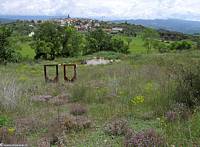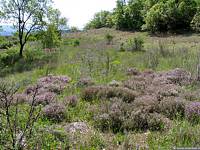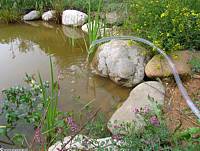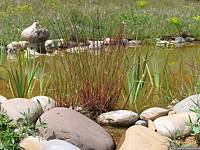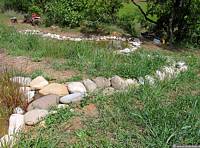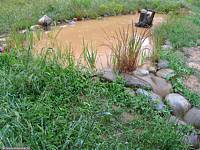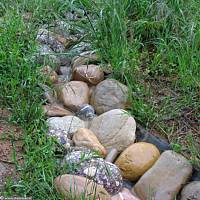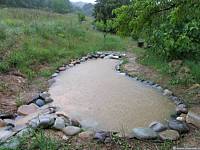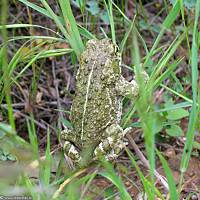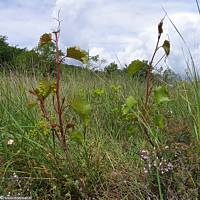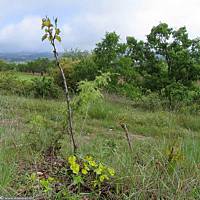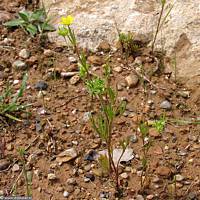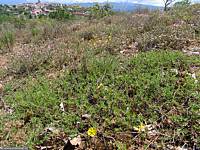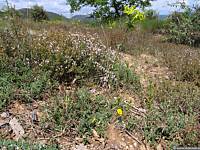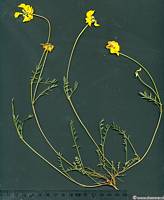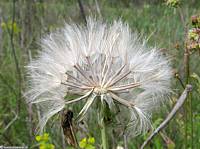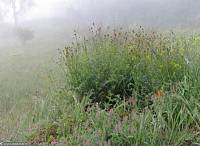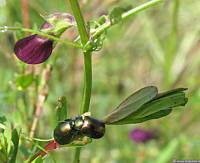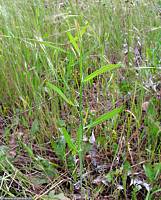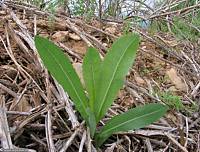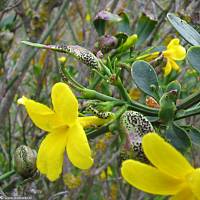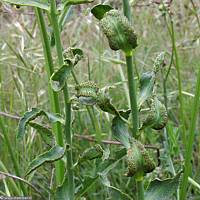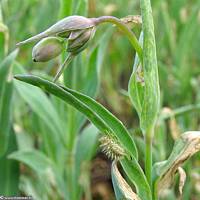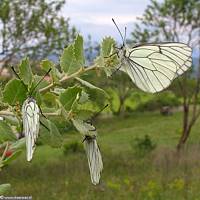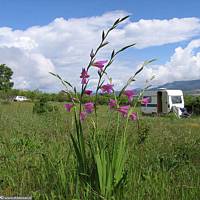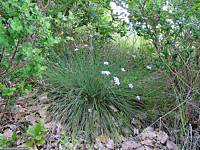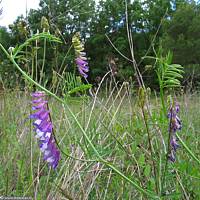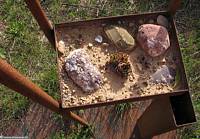|
|
Nature
Switched On
|
|
|
introduction
|
2008 May 24 & 25, Saturday & Sunday This month of May has been
extremely rainy. For our city Zaragoza it has already amounted to
120 litres/m2 and it could possibly reach a historic record by the
end of the month as they expect more precipitations.
Temperatures reach hardly 20ºC on the terrain.
Needless to say that the vegetation enjoys the
weather and offers a splendid look. We ourselves are getting a bit
tired of so much rain, partly because it doesn't let us do the
things we had planned. The foundation wall offers almost the same
aspect as one month ago.
|
Overview of the central eastern
terrace, looking east.Thymus vulgaris and Hieracium pillosella
in the foreground, with dispersed yellow Euphorbia cyparissias
all over the terrain. |
|
The foundation walls, partly
levelled at the top and spaces on the outside filled with lime
mortar. |
||
|
This tube (15 mm) was later covered with stones
and earth. On the left in the water Veronica beccapunga,
recently planted. It stays green in winter and swallows
important quantities of nitrate. |
I used the extra 'free' time to install a submerged water pump. It
takes water from the second pond up to the first pond. This will
keep the water level in the latt
|
|
|
The channel leading to the second pond. |
Outlet of the first pond. The
red grass is Lolium perenne (and not Setaria
pumila as I commented on
26 April 2008.) Photograph taken on 17 May 12:21 |
|
|
The sutil murmur of the stream was completely overruled by the frequent
thunderstorms with pouring rain. The stream almost converted into a
river and the drain from the second pond to the water deposit could
hardly manage the inflow. I think we could easily have filled 2 or 3
deposits (of 2000 litre each) more. But for the moment the system works fine
and only the water deposit needs a more solid drain for when it's
overflowing. It's a pity that the water was carrying so much dirt,
turning the pond water again into a 'cafe con leche'. I expect this
will become less of a problem i
|
||
|
Storm over the village. |
||
|
Rainwater coming down through the channel. |
The first pond. Sunday (25 May) 12:23. |
|
|
The second pond. Sunday (25 May) 12:20. |
||
|
The tadpoles were significantly reduced in numbers by some sort of predator, especially in the first pond. But with the rains the Natterjack toads (Epidalea calamita) returned and started croaking again in the evenings and we observed new strings of eggs.
|
||
|
Curious how this Natterjack toad almost runs
through the vegetation. It never jumps. |
||
|
There are some 5 or 6 vines on the terrain and I decided to prune them decently to avoid the wild uncontrolled growing of anterior years and stimulate flowers and fruit. This mainly means cutting some shoots back to the first 2 buttons and taking away all the rest. The pruning seems never to stop because new shoots keep appearing every week. In the near future I plan to install some sort of trellis. |
||
|
3 vine stubs in the centre of the terrain. |
Will these flowers produce our
first grapes? Photograph taken on 17 May 12:00 |
|
|
Six new plants were identified, bringing the total number of vascular plant species to almost 230:
This Corn buttercup (Ranunculus arvensis) is still quite common in Spain but is increasingly rare in England and the Netherlands (red listed). It is an indicator of soil disturbance and is growing here perhaps because of the stones I placed here a year ago or some digging by a rabbit.
As its Latin name suggests this Fumana procumbens grows near the ground with its lignified stems and very narrow leaves. A close cousin of the Rock roses (Helianthemum).
Another creeping perennial is this Argyrolobium zanonii,
here growing together with Thymus vulgaris and
Euphorbia cyparissias.
|
||
|
Some fifteen plants of Corn buttercup, with
their typical spiky fruit, were
growing among the stones on the central higher terrace. |
||
|
Fumana procumbens
on the lower eastern terrace, looking east. Photograph taken on 18 May 12:38 |
||
|
Argyrolobium zanonii on the
central lower terrace, looking north-west. |
||
|
Hippocrepis comosa on the
foreground, Lotus corniculatus on the background. |
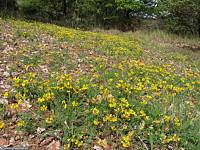
The plant below I have only seen with buttons or with fruit. It flowers only a short time in the morning (with sun) like Goatsbeards (Tragopogon), which it resembles in more aspects. It is Cutleaf Vipergrass (Scorzonera laciniata). Better known is the edible Black salsify (Scorzonera hispanica) from which it can be distinguished by the inflated lower part of the fruit.
|
|
|
Scanned Hippocrepis
comosa. 26 May 2008 |
||
|
Scorzonera laciniata on the lower
western terrace. |
||
|
Typical dominating plants for this time of the year in the more densely covered areas are Salad Burnet (Sanguisorba minor) and Vicia peregrina.
|
||
|
Vicia peregrina,
Bromus diandrus and Hypericum perforatum.
|
Sanguisorba minor
with Fumaria officinalis and Barbarea
vulgaris on the central western
terrace. Photograph taken on 18 May 7:45
|
|
|
Some beetles on Hypericum perforatum (clearly
perforated) with a flower of Vicia peregrina. |
||
|
Rush skeletonweed (Chondrilla juncea )
is not yet dominating but preparing to do so for the coming summer
months. I observed the same phenomena as c |
||
|
Chondrilla juncea is omnipresent on the terrain. Photograph taken on 18 May 19:05 |
|
|
|
Fungi and bacteria must also thrive well these days.
Seve
P.S. March 2013. The monster has been identified as the larva of Subcoccinella vigintiquattuorpunctata, or the 24-Spot ladybird beetle, thanks to an attentive reader, Andrea Berardi. The monster is somewhat of a rarity in the family for being vegetarian. |
||
|
Jasminum fruticans
with infected leaves and sepals. Photograph taken on 18 May 18:12 |
||
|
Infected and deformed Cypress Spurge (Euphorbia
cyparissias). Photograph taken on 18 May 18:34 |
Unidentified monster attacking Silene vulgaris. |
|
|
A |
||
|
A Shieldbug and two Froghoppers on Verbascum sinuatum,
whose typical star-like hairs can be distinguished. Photograph taken on 17 May 13:24 |
|
|
|
Several interesting plants that were present with only a couple of specimen last year seem to have expanded their territory this year. I have already mentioned the case of Orchis purpurea, but now I can also mention the beautiful Gladiolus illyricus, together with Verbascum blattaria (not yet flowering) and Aphyllanthes monspeliensis. |
||
|
At least 30 plants of Gladiolus illyricus are now present on the
central and higher, western terrace. Looking north-west. Photograph taken on 17 May 11:23 |
On the other extreme of the
terrain (lower eastern terrace) Aphyllanthes monspeliensis
is proliferating. Photograph taken on 18 May 17:53 |
|
|
A common plant, although sparsely present on the terrain is the beautiful Fine-leaved Vetch (Vicia tenuifolia).
This miniature rusty desert landscape must represent a very special 'eco-system'. The succulent Sempervivums and Sedums seem to survive the picking of birds, extreme dryness and, recently, the flooding by the heavy rainfall. |
||
|
Vicia tenuifolia growing on only one spot on the
central higher terrace. Photograph taken on 24 May 17:19 |
||
|
Iron 'sculpture' on the central
terrace. Photograph taken on 4 May 9:33 |
||
|
introduction
|
|
